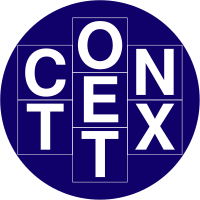|
ConTeXt
ConTeXt is a general-purpose document processor. Like LaTeX, it is derived from TeX. It is especially suited for structured documents, automated document production, very fine typography, and multilingual typesetting. It is based in part on the TeX typesetting system, and uses a document markup language for manuscript preparation. The typographical and automated capabilities of ConTeXt are extensive, including interfaces for handling microtypography, multiple footnotes and footnote classes, and manipulating OpenType fonts and features. Moreover, it offers extensive support for colors, backgrounds, hyperlinks, presentations, figure-text integration, and conditional compilation. It gives the user extensive control over formatting while making it easy to create new layouts and styles without learning the low-level TeX macro language. While comparisons can be made between ConTeXt and LaTeX, the primary objectives of the two systems are distinct. From the onset, ConTeXt has been a typography and typesetting system designed to give users straightforward and consistent access to advanced typographical control, which is crucial for general-purpose typesetting. LaTeX's original vision, on the other hand, was to insulate the user from typographical decisions—an approach particularly useful for tasks such as submitting articles to a scientific journal. Although LaTeX has evolved from this original vision, ConTeXt's unified design prevents the package clashes often experienced with LaTeX.[6][7] ConTeXt provides a multilingual user interface with support for markup in English, Dutch, German, French, and Italian and support for output in many scripts including western European, eastern European, Arabic, Chinese, Japanese, and Korean. It also allows the user to use different TeX engines like LuaTeX (MkIV) and LuaMetaTeX (LMTX). Older versions (MkII) worked with pdfTeX or XeTeX.[7] As its native drawing engine, ConTeXt integrates a superset of MetaPost called MetaFun,[7] which allows users to draw page backgrounds and ornaments with MetaPost. MetaFun can also be used directly with MetaPost. ConTeXt also supports the use of other external drawing engines, like PGF/TikZ[8] and PSTricks.[9] ConTeXt also provides a macro package for typesetting chemical structure diagrams with TeX called PPCHTeX,[10] as well as many other modules.[9][11][12] This package can also be used with plain TeX and LaTeX. Originally entitled pragmatex, ConTeXt was given its name around 1996[13] by Hans Hagen from PRAGMA Advanced Document Engineering (Pragma ADE), a Netherlands-based company. LicenseConTeXt is free software: the program code (i.e. anything not under the The ConTeXt official manual(2001) and ConTeXt official mini tutorial (1999) are documents copyrighted by Pragma, but there is a repository of the future new manual[15] released under the GNU Free Documentation License.[16][17] As of April 2009 there is an up-to-date version of the fonts and typography chapters.[18] VersionsThe current version of ConTeXt is LMTX, introduced in April 2019 as the successor to Mark IV (MkIV).[19] Previous versions — Mark II (MkII) and Mark I — are no longer maintained. According to the developers, the principal difference between LMTX and its predecessors is that the newest version "uses a compilation and scripting engine that is specifically developed with ConTeXt in mind: LuaMetaTeX ... [which] has been optimised heavily for ConTeXt use." Previously, MkIV used LuaTeX and MkII used pdfTeX. HistoryConTeXt was created by Hans Hagen[20] and Ton Otten of Pragma ADE in the Netherlands[21] around 1991[22][23] due to the need for educational typesetting material. Around 1996, Hans Hagen coined the name ConTeXt meaning "text with tex" (con-tex-t; "con" is a Latin preposition meaning "together with").[20] Before 1996 ConTeXt was used only within Pragma ADE, but in 1996 it began to be adopted by a wider audience. The first users outside Pragma were Taco Hoekwater, Berend de Boer and Gilbert van den Dobbelsteen, and the first user outside the Netherlands was Tobias Burnus.[20] In July 2004, contextgarden.net wiki page was created.[22][24] ConTeXt low-level code was originally written in Dutch. Around 2005, the ConTeXt developers began translating this to English, resulting in the version known as MKII, which is now stable and frozen[citation needed]. In August 2007, Hans Hagen presented the MKIV version,[23][25] and the first public beta was released later that year.[26] During the ConTeXt User Meeting 2008, Mojca Miklavec presented[27] ConTeXt Minimals, a distribution of ConTeXt containing the latest binaries and intended to have a small memory footprint, thus demanding less bandwidth for updates.[28] In August 2008, this distribution was registered as a project in launchpad web site.[29] In June 2008, Patrick Gundlach wrote the first post[30] in ConTeXt blog. In July 2009, ConTeXt started git repository.[31] In November 2010, the ConTeXt Group was created.[32] In April 2019, LMTX (ConTeXt LuaMetaTeX) was announced.[33] Example of codeMaking ConTeXt documents is simple: one makes a plain text file, and compiles it with the ConTeXt documents come with the file extension .tex or an extension demarking the version required: See alsoReferences
External links
Official pages
Manuals and tutorials
Comparison between ConTeXt and LaTeX
|
||||||||||||||||||
Portal di Ensiklopedia Dunia

